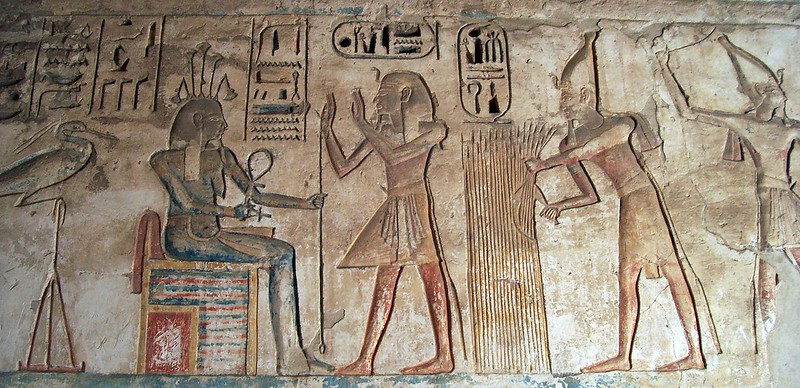
In recent research, experts employed X-rays to uncover the gradual development of 3000-year-old paintings in Egypt’s Theban Necropolis. These discoveries published in PLOS ONE offer valuable insights into the artistic methods employed to create these remarkable ancient artworks.
The utilization of X-ray technology to examine ancient Egyptian wall paintings is considered a significant breakthrough, according to Marine Cotte, a chemist at the European Synchrotron Radiation Facility, who collaborated with the study’s authors in the past but was not directly involved in this particular research endeavor.
X-ray fluorescence technique
In the past few years, scientists and art historians from various countries have collaborated to employ a technology called X-ray fluorescence. This technique has enabled them to discover hidden paint colors and underlying traced lines in renowned artworks.
Each paint color possesses a unique chemical makeup. By subjecting paintings to X-rays and analyzing the absorption patterns, scientists can identify the specific pigments on and beneath the surface. This method unveils the artistic errors that artists concealed and provides insights into the step-by-step progress that led to the final celebrated outcomes.
Challenges faced during the research
Most of the research in this field has traditionally taken place in museums or laboratories, where smaller and portable objects can be conveniently transported to the machinery. However, this approach becomes challenging when dealing with wall paintings in underground tombs.
To overcome this obstacle, an interdisciplinary team comprising art historians, Egyptologists, and engineers utilized two portable X-ray machines, effectively bringing the laboratory to the tombs themselves. This innovative approach allowed the researchers to explore beneath the surface of the paintings without causing any damage.
The Theban Necropolis, which includes the famous tomb of Tutankhamun, is home to numerous tombs adorned with paintings that serve as tributes to the deceased. These artworks are widely regarded as the pinnacle of ancient Egyptian painting.
I'm posting this thread for all the ignoramuses out there who talk about ancient Egyptian art while using pics from Google. I took these pictures with my own camera, from the tomb of Nefertari. They are unedited, undoctored, and straight from my camera roll. pic.twitter.com/8qltqdrE5N
— Septimius Severus (@Calamondins1) April 28, 2023
Conducting X-ray examinations posed its own set of difficulties: transporting the delicate machines through the desert to reach the tombs’ remote and restricted areas, inaccessible to tourists.
Once inside the warm and humid funerary chapels, the process became slow and meticulous. Each small area required up to 3 hours to scan, with scientists crouching down and working centimeter by centimeter in absolute silence.
Catherine Defeyt, co-author of the study and an art conservation scientist at the University of Liège, describes the experience as being immersed in the essence of humanity while working in the tombs.
Analysis of the data
Upon analyzing the collected data, the researchers were taken aback by the unexpected findings. Prior to the study, many Egyptologists held the belief that the vast number of Egyptian paintings within the Necropolis implied a systematic assembly line process, leaving no room for artists to revisit and modify their work.
However, when X-rays were performed on a renowned portrait of Rameses II, who reigned from 1279 B.C.E. to 1213 B.C.E., traces of an earlier version of the painting were unveiled.
The earlier depiction of Rameses II showcased a shorter crown, a different scepter, and a modified necklace. The research team eloquently describes this discovery as “a remarkable encounter with the ghost of the painters at work.”
Thomas Christiansen, an Egyptologist from the Danish National Encyclopedia who was not directly involved in the study, expressed surprise at the extent of the reworking observed. He believes that these hidden details offer valuable insights into the mindset and craftsmanship of ancient Egyptian artists.
Painters’ revisions still remain a mystery
Understanding the exact reasons behind the painters’ revisions, such as altering the position of an arm, remains a mystery that is difficult to comprehend in present times, as acknowledged by the authors.
Christiansen speculates that these revisions indicate a scenario where a master artist conceptualized the project, while apprentices carried out the initial painting, and the master later made corrections.
He suggests that more effort was invested in bringing a preconceived artistic vision to life than previously assumed.
Philippe Martinez, the lead author of the study and an Egyptologist at Sorbonne University, emphasizes that this revelation signifies the imperfections of artistic creations, highlighting the humanity of the artists. It showcases that “nothing is perfect,” which, in Martinez’s view, adds to the greatness of their artistic endeavors.
See all the latest news from Greece and the world at Greekreporter.com. Contact our newsroom to report an update or send your story, photos and videos. Follow GR on Google News and subscribe here to our daily email!



